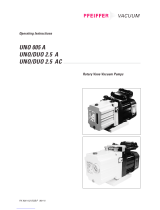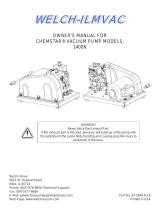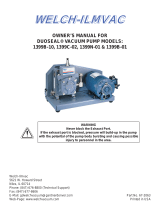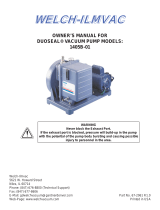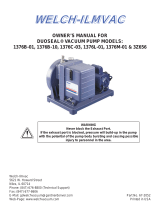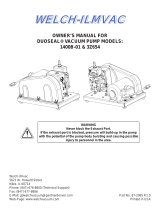Page is loading ...

OPERATING INSTRUCTIONS
EN
Translation of the Original
OKTA 1000 | OKTA 1000 M
Roots pump

Dear Customer,
Thank you for choosing a Pfeiffer Vacuum product. Your new roots pump should support you
in your individual application with full performance and without malfunctions. The name
Pfeiffer Vacuum stands for high-quality vacuum technology, a comprehensive and complete
range of top-quality products and first-class service. From this extensive, practical experience
we have gained a large volume of information that can contribute to efficient deployment and
to your personal safety.
In the knowledge that our product must avoid consuming work output, we trust that our
product can offer you a solution that supports you in the effective and trouble-free
implementation of your individual application.
Please read these operating instructions before putting your product into operation for the
first time. If you have any questions or suggestions, please feel free to contact info@pfeiffer-
vacuum.de.
Further operating instructions from Pfeiffer Vacuum can be found in the Download Center on
our website.
Disclaimer of liability
These operating instructions describe all models and variants of your product. Note that your
product may not be equipped with all features described in this document. Pfeiffer Vacuum
constantly adapts its products to the latest state of the art without prior notice. Please take
into account that online operating instructions can deviate from the printed operating
instructions supplied with your product.
Furthermore, Pfeiffer Vacuum assumes no responsibility or liability for damage resulting from
the use of the product that contradicts its proper use or is explicitly defined as foreseeable
misuse.
Copyright
This document is the intellectual property of Pfeiffer Vacuum and all contents of this
document are protected by copyright. They may not be copied, altered, reproduced or
published without the prior written permission of Pfeiffer Vacuum.
We reserve the right to make changes to the technical data and information in this document.
2/52

Table of contents
1 About this manual 7
1.1 Validity 7
1.1.1 Applicable documents 7
1.1.2 Product variants affected 7
1.2 Target group 7
1.3 Conventions 8
1.3.1 Instructions in the text 8
1.3.2 Pictographs 8
1.3.3 Stickers on the product 8
1.3.4 Abbreviations 9
2 Safety 10
2.1 General safety instructions 10
2.2 Safety instructions 10
2.3 Safety precautions 13
2.4 Product usage limits 14
2.5 Proper use 14
2.6 Foreseeable improper use 14
3 Product description 16
3.1 Functional description 16
3.2 Product identification 16
3.3 Product features 17
3.4 Shipment 17
4 Transportation and Storage 18
4.1 Transporting the vacuum pump 18
4.2 Storing the vacuum pump 19
5 Installation 20
5.1 Installing the vacuum pump 20
5.2 Filling with lubricant 20
5.3 Filling with sealing oil 21
5.4 Connecting the vacuum side 22
5.5 Connecting the fore-vacuum side 23
5.6 Establishing mains connection 23
5.6.1 Connecting a three phase motor with 6-pin terminal board 24
5.6.2 Checking the direction of rotation 25
5.6.3 Connect the PTC thermistor temperature sensor (PTC) 25
6 Operation 27
6.1 Putting the vacuum pump into operation 27
6.2 Switching on the vacuum pump 27
6.3 Adjusting the sealing gas amount 28
6.4 Flushing the suction chamber 28
6.5 Switching off and venting 29
6.6 Re-start (to) 30
7 Maintenance 31
7.1 Maintenance information 31
7.2 Checklist for inspection and maintenance 31
7.3 Changing the lubricant 33
7.4 Changing the sealing oil 34
7.5 Cleaning the suction chamber 35
7.6 Cleaning the overflow valve 36
7.7 Installing the coupling 37
7.8 Installing the coupling for versions with magnetic coupling 38
Table of contents
3/52

8 Decommissioning 39
8.1 Shutting down for longer periods 39
8.2 Recommissioning 39
8.3 Disposing of the vacuum pump 39
9 Malfunctions 41
10 Service solutions from Pfeiffer Vacuum 43
11 Spare parts 45
11.1 Set of seals for version with RSSR 45
11.2 Set of seals for version with magnetic coupling 45
11.3 Maintenance kit for version with RSSR 45
11.4 Maintenance kit for version with magnetic coupling 45
12 Accessories 46
12.1 Sealing gas device 46
12.2 Flushing device 46
12.3 Gear space extraction 46
12.4 Protective strainer 46
13 Technical data and dimensions 47
13.1 General 47
13.2 Technical data 47
13.3 Dimensions 48
Declaration of conformity 50
Table of contents
4/52

List of tables
Tbl. 1: Stickers on the product 9
Tbl. 2: Abbreviations used 9
Tbl. 3: Usage limits of the vacuum pump 14
Tbl. 4: Features of the roots pumps 17
Tbl. 5: Max. permissible flushing quantity 29
Tbl. 6: Maintenance intervals 33
Tbl. 7: Troubleshooting 42
Tbl. 8: Available spare parts packages 45
Tbl. 9: Conversion table: Pressure units 47
Tbl. 10: Conversion table: Units for gas throughput 47
Tbl. 11: Technical data Okta 1000 Standard | M 48
Tbl. 12: Dimensions Okta 1000 Standard | M 49
List of tables
5/52

List of figures
Fig. 1: Position of the labels on the product 9
Fig. 2: Design, construction 16
Fig. 3: Transporting the vacuum pump 19
Fig. 4: Filling with lubricant 21
Fig. 5: Filling sealing oil for radial shaft seal rings 22
Fig. 6: Delta connection for low voltage 24
Fig. 7: Star circuit for high voltage 24
Fig. 8: Check of direction of rotation 25
Fig. 9: Connection example with PTC thermistor tripping unit 26
Fig. 10: Drain the lubricant 34
Fig. 11: Replacing the sealing oil for radial shaft seal rings 35
Fig. 12: Overflow valve 36
Fig. 13: Installation instructions gear rim coupling 37
Fig. 14: Dimension diagram Okta 1000 Standard | M 48
List of figures
6/52

1 About this manual
IMPORTANT
Read carefully before use.
Keep the manual for future consultation.
1.1 Validity
These operating instructions are for customers of Pfeiffer Vacuum. They describe the function of the
designated product and provide the most important information for safe usage of the product. The de-
scriptions comply with applicable directives. All information provided in these operating instructions refer
to the current development status of the product. The documentation remains valid as long as the cus-
tomer does not modify the product in any way.
1.1.1 Applicable documents
Document Number
Declaration of conformity A component of these instruc-
tions
Additional information for "M Version" PW 0142 BN
Supplementary Information for Roots pumps with special overflow
valves
PW 0022 BN
1.1.2 Product variants affected
These instructions apply for roots pumps of the following versions:
Pump type Pump designs
Standard ver-
sion
Standard version:
●
Standard motor
●
The housing and all parts forming the suction chamber consist of GG and GGG
●
Connection flanges are designed as ISO flanges
●
Overflow valve for protection against thermal overload
M version Changes to the standard design:
●
Version with magnetic coupling
Special ver-
sions
●
Various pressure differentials at the overflow valve
●
Special seal materials which are resistant to aggressive media
●
Coated pump interior for corrosion protection and/or good anti-sticking properties
●
special, process-specific lubricants
1.2 Target group
This operating instructions are aimed at all persons performing the following activities on the product:
●
transport,
●
setup (installation),
●
usage and operation,
●
decommissioning,
●
maintenance and cleaning,
●
storage or disposal.
The work described in this document is only permitted to be performed by persons with the appropriate
technical qualifications (expert personnel) or who have received the relevant training from Pfeiffer Vac-
uum.
About this manual
7/52

1.3 Conventions
1.3.1 Instructions in the text
Usage instructions in the document follow a general structure that is complete in itself. The required ac-
tion is indicated by an individual step or multi-part action steps.
Individual action step
A horizontal, solid triangle indicates the only step in an action.
►
This is an individual action step.
Sequence of multi-part action steps
The numerical list indicates an action with multiple necessary steps.
1. Step 1
2. Step 2
3. ...
1.3.2 Pictographs
Pictographs used in the document indicate useful information.
Note
Tip
1.3.3 Stickers on the product
This section describes all the stickers on the product along with their meaning.
Mod.: Okta 1000
Weight: 240 kg
3
D-35641 Asslar
Made in Germany
Mod.-No.: PP W41 ...
n: max. 4500 1/min Oil: P3 2,9 l
S(N): max. 1775 m /h
02/2019
Ser. -No.:
143..............
Rating plate (example)
The rating plate is located on the front side above the sight
glass
Motor rating plate (not shown)
Vor Inbetriebnahme Pumpe mit Öl
füllen
Fill the pump with oil before putting
into operation
Remplir la pompe d’huile avant la mise
en route
Sticker (red)
Before commissioning, fill the gear and bearing chambers with
lubricant
Achtung!
nur mit D1 befüllen
Attention!
only D1 to be used
Sticker (blue) – special lubricant only
Caution: fill with D1 only
Achtung!
nur mit F5 befüllen
Attention!
only F5 to be used
Adhesive label (orange) – only in case of special lubri-
cants
Caution: fill with F5 only
About this manual
8/52

Warning hot surface
This sticker warns of injuries caused by high temperatures in
case of touching without protection during operation.
Warning of magnetic field
This adhesive label warns of injuries to people with pacemak-
ers.
Tbl. 1: Stickers on the product
1
2
3
4
5
6
Fig. 1: Position of the labels on the product
1 Rating plate 4 Fill lubricant note
2 Magnetic field warning sign 5 Note D1/F5 lubricant
3 Direction of rotation arrow (cast in the cover) 6 Hot surface warning sign
1.3.4 Abbreviations
Abbreviation Explanation
PTC Temperature-dependent resistor (Positive Temperature Coefficient)
M version Roots pumps with magnetic coupling
RSSR Radial shaft seal ring
WAF width across flats
E Clearance between both coupling halves
GGG Spheroidal graphite cast iron
GG Cast iron with lamellar graphite
FPM Fluoropolymer rubber
PN Nominal pressure stage (pressure nominal)
ISO International Organization for Standardization
DIN German Institute for Standardization (Deutsches Institut für Normung)
f Rotation speed value of a vacuum pump (frequency, in rpm or Hz)
p Intake pressure or general pressure in [hPa]
OI Operating instructions
SI Service instructions
Tbl. 2: Abbreviations used
About this manual
9/52

2 Safety
2.1 General safety instructions
This document includes the following four risk levels and one information level.
DANGER
Imminent danger
Indicates a hazardous situation which, if not avoided, will result in death or serious injury.
►
Instructions on avoiding the hazardous situation
WARNING
Possibly imminent danger
Indicates a hazardous situation which, if not avoided, could result in death or serious injury.
►
Instructions on avoiding the hazardous situation
CAUTION
Possibly imminent danger
Indicates a hazardous situation which, if not avoided, could result in minor or moderate injury.
►
Instructions on avoiding the hazardous situation
NOTICE
Danger of property damage
Notice is used to address practices not related to physical injury.
►
Instructions on avoiding property damage
Notes, tips or examples indicate important information on the product or on this document.
2.2 Safety instructions
All safety instructions in this document are based on the results of the risk assessment carried out in
accordance with Machinery Directive 2006/42/EC Annex I and EN ISO 12100 Section 5. Where applica-
ble, all life cycle phases of the product were taken into account.
Risks during transport
WARNING
Risk of serious injury from swinging, toppling or falling objects
During transport, there is a risk of crushing and impact on swinging, toppling or falling objects. There
is a risk of injuries to limbs, up to and including bone fractures and head injuries.
►
Secure the danger zone if necessary.
►
Pay attention to the center of gravity of the load during transport.
►
Ensure even movements and moderate speeds.
►
Observe safe handling of the transport devices.
►
Avoid sloping attachment aids.
►
Never stack products.
►
Wear protective equipment, e.g. safety shoes.
Safety
10/52

Risks during installation
DANGER
Danger to life from electric shock
Contact with exposed and live elements generate an electric shock. Incorrect connection of the mains
supply leads to the risk of live housing parts that can be touched. There is a risk to life.
►
Before the installation, check that the connection leads are voltage-free.
►
Make sure that electrical installations are only carried out by qualified electricians.
►
Provide adequate grounding for the device.
►
After connection work, carry out an earthed conductor check.
WARNING
Risk of crushing from rotating parts
Fingers and hands may be caught by rotating pistons within the connection flange. This results in se-
vere injuries.
►
Keep limbs out of the reach of the roots pump.
CAUTION
Danger of injury from bursting as a result of high pressure in the exhaust line
Faulty or inadequate exhaust pipes lead to dangerous situations, e.g., increased exhaust pressure.
There is a danger of bursting. Injuries caused by flying fragments, the escaping of high pressure, and
damage to the unit cannot be excluded.
►
Route the exhaust line without shut-off units.
►
Observe the permissible pressures and pressure differentials for the product.
►
Check the function of the exhaust line on a regular basis.
CAUTION
Risk of injury from loss of stability
During setup, there is a risk of injury from tipping, if the vacuum pump is not anchored on the stand-
ing surface.
►
Secure the vacuum pump using suitable lifting gear.
►
Wear personal protective equipment.
CAUTION
Danger of injury from moving parts
After a power failure or a standstill as a result of overheating, the motor restarts automatically. There
is a risk of injury to fingers and hands if they enter the operating range of rotating parts.
►
Safely disconnect motor from the mains.
►
Secure the motor against reactivation.
►
Dismantle the vacuum pump for inspection, away from the system if necessary.
Risks during operation
WARNING
Danger of poisoning due to toxic process media escaping from the exhaust pipe
During operation with no exhaust line, the vacuum pump allows exhaust gases and vapors to escape
freely into the air. There is a risk of injury and fatality due to poisoning in processes with toxic process
media.
►
Observe the pertinent regulations for handling toxic process media.
►
Safely purge toxic process media via an exhaust line.
►
Use appropriate filter equipment to separate toxic process media.
Safety
11/52

WARNING
Risk of crushing on rotating parts when reaching into the open flange
The pistons continue to run in the vacuum after switching off the motor, and can trap fingers and
hands within their reach.
►
Wait until the vacuum pump comes to a complete standstill.
►
Secure the vacuum pump against re-start.
CAUTION
Danger of burns on hot surfaces
Depending on the operating and ambient conditions, the surface temperature of the vacuum pump
can increase to above 70 °C.
►
Provide suitable touch protection.
CAUTION
Health hazard from increased noise emission
Remaining in the close proximity of the vacuum pump for a sustained period of time may cause hear-
ing damage.
►
Ensure adequate sound insulation.
►
Wear hearing protection.
Risks during maintenance, decommissioning and malfunctions
WARNING
Danger of injury from strong magnetic field
There is a risk of injury for people with pacemakers and medical implants.
►
Make sure that such individuals do not enter the sphere of influence (≤ 2 m) of the magnetic field.
►
Identify rooms in which magnetic couplings are openly accessible with the symbol: "No access
for people with pacemakers".
►
Always keep disassembled couplings away from computers, data carriers, and other electronic
components.
WARNING
Health hazard through poisoning from toxic contaminated components or devices
Toxic process media result in contamination of devices or parts of them. During maintenance work,
there is a risk to health from contact with these poisonous substances. Illegal disposal of toxic sub-
stances causes environmental damage.
►
Take suitable safety precautions and prevent health hazards or environmental pollution by toxic
process media.
►
Decontaminate affected parts before carrying out maintenance work.
►
Wear protective equipment.
WARNING
Risk of crushing from rotating parts
Fingers and hands may be caught by rotating pistons within the connection flange. This results in se-
vere injuries.
►
Keep limbs out of the reach of the roots pump.
Safety
12/52

WARNING
Health hazard and environmental damage from toxic contaminated lubricant
Toxic process media can cause lubricant contamination. When changing the lubricant, there is a
health hazard due to contact with poisonous substances. Illegal disposal of toxic substances causes
environmental damage.
►
Wear suitable personal protective equipment when handling these media.
►
Dispose of the lubricant according to locally applicable regulations.
WARNING
Danger of injury due to exposed rotating parts
In the operating range of the motor coupling, there is a danger of clothing being caught and wound
up.
►
When assembling the motor and coupling, make sure that the coupling protection is seated cor-
rectly.
►
Wear correct clothing.
CAUTION
Scalding from hot lubricant
Danger of scalding when draining lubricant if it comes into contact with the skin.
►
Wear personal protective equipment.
►
Use a suitable collection receptacle.
2.3 Safety precautions
Duty to provide information on potential dangers
The product holder or user is obliged to make all operating personnel aware of dangers
posed by this product.
Every person who is involved in the installation, operation or maintenance of the product
must read, understand, and adhere to the safety-related parts of this document.
Infringement of conformity due to modifications to the product
The Declaration of Conformity from the manufacturer is no longer valid if the operator
changes the original product or installs additional equipment.
●
Following installation into a system, the operator is required to check and re-evaluate
as necessary the conformity of the overall system in the context of the relevant Europe-
an Directives before commissioning that system.
General safety precautions
►
Do not expose body parts to the vacuum.
►
Check all safety measures at regular intervals.
►
Observe the safety and accident prevention regulations, if necessary wear personal protective
equipment.
►
Always ensure a secure connection to the earthed conductor (PE), protection class I.
►
Never operate the vacuum pump with open vacuum flange.
►
Provide suitable touch protection, if the surface temperature exceeds 70°C.
►
Provide appropriate noise protection measures in case the sound pressure level requires this.
►
Before working on the vacuum connection, wait until the rotor is at a complete standstill (rotation
speed f = 0).
►
Do not carry out your own conversions or modifications on the vacuum pump.
►
Before returning the vacuum pump, observe the notes in the chapter Service.
Safety
13/52

2.4 Product usage limits
Parameter Okta
Installation location
●
Indoors, protected against:
─
dust deposits
─
falling objects
─
fire-fighting water
●
Outdoors, protected against:
─
falling objects
─
direct influence of weather such as rain, splash water, strong
drafts and sunlight
─
fire-fighting water
─
lightning strike
Installation altitude max. 2,000 m above sea level,
at installation altitudes > 1,000m above m.s.l. and an ambient tempera-
ture of 40 °C the rated power of the motor reduces by around 10 %
Ambient temperature +5 °C to +40 °C
Relative air humidity max. 85 % (depending on the motor version)
Gas temperature, pressure
side, max.
+200 °C
Intake pressure, max. < 1,100 hPa (abs.)
Orientation Horizontal
Tbl. 3: Usage limits of the vacuum pump
2.5 Proper use
►
Use the vacuum pump for vacuum generation only.
►
When pumping media with an oxygen concentration level of > 21 %, only use perfluorinated, syn-
thetic oils (F5) as lubricant.
►
Depending on the process and if necessary, use sealing gas.
–
Evacuating high-boiling media (e.g. solvents) degrades the lubricant.
►
Operate the vacuum pump within application limits (see: Product usage limits and Technical data).
►
Adhere to the installation, commissioning, operating, and maintenance instructions.
►
Use only accessory parts recommended by Pfeiffer Vacuum.
2.6 Foreseeable improper use
Improper use of the product invalidates all warranty and liability claims. Improper use is any, even unin-
tended, use, which is contrary to the product purpose; and in particular:
●
Transport, installation or operation of the vacuum pump in an impermissible spatial position
●
Pumping media that can corrode or not be withstood by vacuum pump materials.
Components contained in the suction chamber are cast iron, steel, and stainless steel. Seals are
FKM (alternative seals available on request).
●
Pumping explosive media
●
Pumping radioactive media
●
Pumping media prone to exothermic reactions
●
Pumping media that introduce an ignition source to the suction chamber
●
Pumping media that can cause adhesive deposits to form in the suction chamber, or the pistons to
start up or jam
●
Pumping fluids - flushing media for cleaning are permissible
●
Using the vacuum pump to generate pressure
●
Using the vacuum pump in systems in which sporadic loads and vibrations or periodic forces act
on the unit
●
Use of the vacuum pump in potentially explosive atmospheres
●
Use of the vacuum pump in areas with strong electrical, magnetic or electromagnetic fields
Safety
14/52

●
Use of the vacuum pump with open vacuum and/or fore-vacuum flange open to the atmosphere
●
Using lubricants not specified by Pfeiffer Vacuum
●
Using pipes to lift the vacuum pump
●
Use of accessories or spare parts that are not listed in these instructions
●
Using the vacuum pump as a climbing aid.
Safety
15/52

3 Product description
3.1 Functional description
The operating principle of the Roots pumps is based on two synchronous pistons which rotate in a
housing without touching. The pumping effects arise as a result of the opposing rotation of the two fig-
ure-of-eight shaped rolling pistons. While suction chambers are formed between the rolling pistons and
the housing, the rolling pistons continuously form a mutual seal without touching each other or the hous-
ing. This opposing yet synchronised movement of the rolling pistons is achieved by means of a pair of
gears mounted on the extended shaft ends. Lubrication is limited to the two bearing and gear chambers
which are arranged separately from the suction chambers. As the roots pump is not capable of com-
pressing against atmospheric pressure, it needs to be operated in conjunction with a backing pump con-
nected upstream.
Roots pumps of the M series are equipped with a magnetic coupling.
1 42 3
9
8
10111214
1315
5 6
7
Fig. 2: Design, construction
1 Vacuum flange 9 Lubricant drain plug
2 Measurement connection vacuum side 10 Fore-vacuum flange
3 Motor 11 Optional fore-vacuum connection
4 Oiler for version with RSSR 12 Sealing gas connection motor side
5 Overflow valve 13 Measurement connection fore-vacuum side
6 Eye bolt 14 Sealing gas connection bearing side
7 Cardboard cover disk 15 Sight glass
8 Lubricant filling plug
3.2 Product identification
To ensure for a clear identification of the product when communicating with Pfeiffer Vacuum, always
keep all of the information on the rating plate to hand.
The following information is shown on the rating plate:
●
Pump model
●
Model number
●
Type and quantity of the lubricant
●
Max. allowable pump rotation speed
●
Date of manufacture
●
Input voltage range
Product description
16/52

3.3 Product features
Flange types Vacuum connec-
tion
Fore-vacuum con-
nection
Sealing gas
connection
Measurement
connection
Okta 1000 DN 160 ISO-F DN 100 ISO-F 4 × G 3/8" 2 × G 3/8"
Okta 1000 M
Okta 1000
pressure surge pro-
tected
DN 150 PN 16 DN 100 PN 16
Okta 1000 M
pressure surge pro-
tected
Tbl. 4: Features of the roots pumps
3.4 Shipment
●
Roots pump
●
Motor-side coupling half for Roots pumps without motor
●
Seal for the connection flange
●
Cover disks for the connecting flanges
●
Screw kit for the connection flange
●
2 eye bolts for lifting the Roots pump
●
Lubricant P3 (standard version)
●
Operating instructions
Product description
17/52

4 Transportation and Storage
4.1 Transporting the vacuum pump
WARNING
Risk of serious injury from swinging, toppling or falling objects
During transport, there is a risk of crushing and impact on swinging, toppling or falling objects. There
is a risk of injuries to limbs, up to and including bone fractures and head injuries.
►
Secure the danger zone if necessary.
►
Pay attention to the center of gravity of the load during transport.
►
Ensure even movements and moderate speeds.
►
Observe safe handling of the transport devices.
►
Avoid sloping attachment aids.
►
Never stack products.
►
Wear protective equipment, e.g. safety shoes.
Instructions for safe transport
●
Only remove the protective cover for the connection flange once the pipes have been
mounted.
●
Fill the gear and bearing chambers with lubricant only once the final installation posi-
tion is reached.
Pfeiffer Vacuum recommends keeping the transport packaging and original protective cov-
er.
General information regarding safe transport
1. Observe weight specified on the rating plate.
2. Where possible, always transport or ship the roots pump in its original packaging.
3. Remove the protective cover only immediately prior to installation.
Transporting the vacuum pump in its packaging
1. Use a pallet truck to transport the vacuum pump in its packaging.
2. Note the center of gravity of the load.
3. Observe safe handling of manually operated transport devices.
4. Ensure harmonious movements and moderate speeds.
5. Ensure a flat substrate.
6. Wear protective equipment, e.g. safety shoes.
Transportation and Storage
18/52

Fig. 3: Transporting the vacuum pump
Transporting the vacuum pump without its packaging
2 eye bolts are included in the shipment, which are firmly bolted to the vacuum pump ex-factory.
1. Unpack the vacuum pump.
2. Attach suitable lifting tools to both eye bolts.
3. Pay attention to the correct use and fastening of the lifting equipment.
4. Lift the vacuum pump out of the transport packaging vertically.
5. If necessary, remove the eye bolts after transport and installation.
–
Keep the eye bolts for future use.
4.2 Storing the vacuum pump
The roots pumps do not have any corrosion protection on the inside. If you intend to store the roots
pump for longer periods, we recommend that you use a special corrosion protection agreed with us.
Procedure
1. Close both connection flanges.
2. Check that the other openings are sealed safely, e.g. sealing gas and measurement connections.
3. Store the roots pump only in dry, dust-free rooms, within the specified ambient conditions:
–
In rooms with humid or aggressive atmospheres, seal the roots pump airtight in a plastic bag,
together with a drying agent.
–
After a storage period of 2 years, Pfeiffer Vacuum recommends changing the lubricant.
The best corrosion protection for the roots pump is achieved by evacuating and then filling the suction
chamber with nitrogen.
Transportation and Storage
19/52

5 Installation
5.1 Installing the vacuum pump
CAUTION
Risk of injury from loss of stability
During setup, there is a risk of injury from tipping, if the vacuum pump is not anchored on the stand-
ing surface.
►
Secure the vacuum pump using suitable lifting gear.
►
Wear personal protective equipment.
General notes for the installation of vacuum components
►
Choose an installation location that permits access to the product and to supply lines at all times.
►
Observe the ambient conditions given for the area of use.
►
Provide the highest possible level of cleanliness during assembly.
►
Ensure that flange components during installation are grease-free, dust-free and dry.
Procedure
1. Check the carrying capacity of the floor at the installation location.
2. Place the vacuum pump on a flat, horizontal and fixed surface, to safeguard the lubricant supply.
–
Reference surface is the vacuum flange.
3. Screw the 4 feet of the vacuum pump on level with the standing surface.
4. If necessary, use adjustment elements from the Pfeiffer Vacuum accessories range for mounting
the feet horizontally.
5. When doing so, make sure that the vacuum pump is not tensioned.
6. When installing the pump in a closed housing, ensure adequate air circulation.
7. Keep both sight glasses freely accessible for checks and maintenance.
8. Ensure that the motor rating plate remains accessible at all times for a clear view of the voltage
and frequency specifications.
9. Maintain the minimum distances to bordering surfaces to guarantee sufficient air circulation.
10. Leave the filling/drain holes and sight glasses freely accessible.
11. Fill with lubricant prior to first commissioning.
5.2 Filling with lubricant
WARNING
Danger of poisoning from toxic vapors
Igniting and heating synthetic lubricants generates toxic vapors. Danger of poisoning if inhaled.
►
Observe the application instructions and precautions.
►
Do not allow tobacco products to come into contact with the lubricant.
NOTICE
Property damage from using non-approved lubricant
Attainment of product-specific performance data is not ensured. If non-approved lubricant is used, all
liability and warranty claims against Pfeiffer Vacuum are excluded.
►
Use approved lubricant only.
►
Use other application-specific lubricant only after consultation with Pfeiffer Vacuum.
The type of lubricant specified for the gear and bearing chambers, and the fill quantity for the entire
roots pump are shown on the rating plate. Only the lubricant used during initial installation is permissi-
ble. Subsequent change is possible only after consultation with Pfeiffer Vacuum.
Installation
20/52
/
